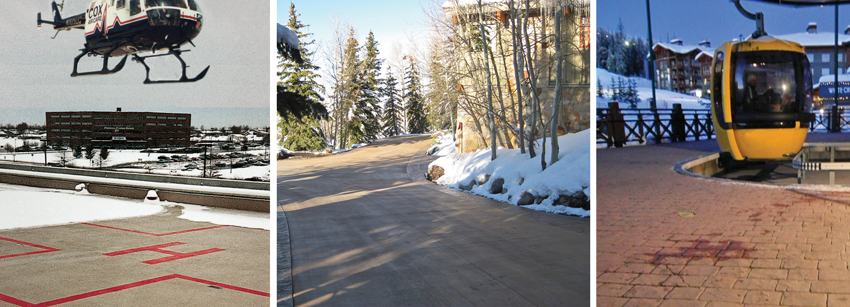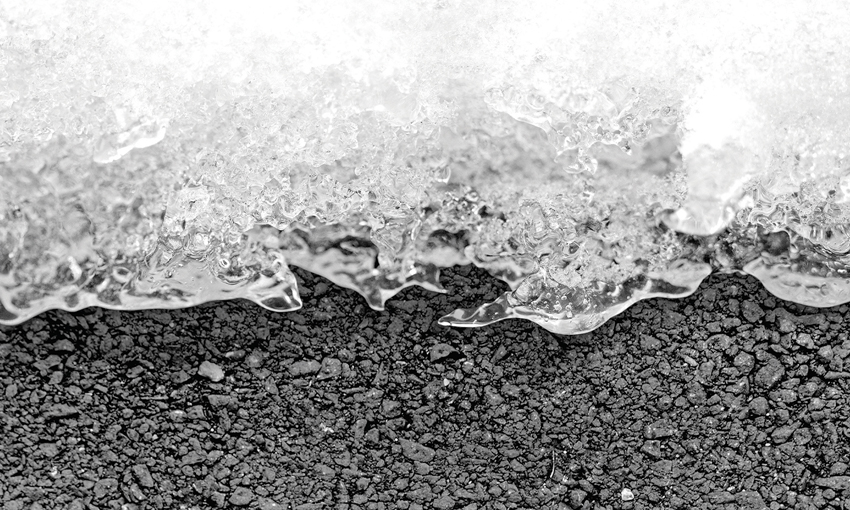Optimizing Snow-Melting Systems
System Types
There are two basic types of snow-melting systems available: electrical systems and hydronic systems. Electrical systems use electric current run through specially designed heat-generating resistance wires to create the needed heat for the snow-melting function. Hydronic systems use a water-glycol fluid circulated through tubing (piping) and boilers to generate heat. Many aspects of these two systems are similar in terms of the principles behind their design, installation, and operation—it is just some of the components and system parts that are different.
The type of system selected for a particular project will often be predicated on the size of the area to be heated. An installation less than 1,500 square feet usually means that electrical is more economical since a boiler is not required. For example, most residential systems are smaller and tend to use an electric rather than hydronic system. Nonetheless, any size system where a boiler or hydronic system is not desired or practical will tend to be electric.
Larger installations often benefit from hydronic systems. This is particularly true if they can be linked to an existing boiler and can gain some overall boiler efficiencies. However, there are many cases where it makes more sense to use an appropriately sized dedicated boiler. Since each building is unique, a review of the applicability of both system types (hydronic versus electric) may be warranted to discern which is the best choice for a particular project. This review should include the practical aspects of installation, costs, benefits, and differences between the two systems.
Regardless of the type selected, all snow-melting systems operate using automatic and manual controls. These controls are essentially the same from the standpoint of the user whether electric or hydronic systems are used. There will be some difference in what is being controlled of course (electric current or hydronic fluids), but the overall concepts and principles are straightforward and well known.
Basic Considerations for Design and Performance
Before designing a snow-melting system, there are several site- and building-specific conditions that need to be addressed. There is also the need to establish proper expectations and quality assurance standards for a system ahead of time. These considerations are reviewed further in the following paragraphs.

Photos courtesy of Watts
Every project must be assessed to determine the owner's needs, particular site conditions, and performance expectations of a system.
Site Conditions
The building site and the specific outdoor areas targeted for a snow-melting system need to be fully assessed to design and install an effective solution. Such an assessment should consider the following:
- Surfaces to be treated: The use of the surface(s) intended for snow-melting should be understood first. Is it a critical use area in constant use or an occasional use area only at certain times of day or the week? Similarly, is there anything about the material used or the surface treatment that needs to be taken into account? For example, is the surface going to be smooth concrete, brick pavers, asphalt, or some other material? A basic understanding of the design intent and material of the surfaces will help inform the different aspects of a site assessment.
- Surrounding area: The surfaces do not exist independently from their surroundings. Rather, buildings and other features around the snow-melting area can have impacts on the snow-melting surface in different ways. Direct solar visibility onto the snow-melting surface could cause melting independently from the system during daylight hours. Conversely, a shaded area may never receive any solar benefit and need to rely entirely on the snow-melting system. By the same token, areas that are prone to wind are different from areas that are protected. Wind can cause drifting and accumulation of snow onto a surface, requiring more attention than those that are protected.
It is important to recognize that a single building can have several different conditions in different specific areas. One walkway may be shielded by adjacent buildings and another may be exposed, for example. A driveway may get 24-hour use but a walkway may not. In cases like these, different conditions need to be accounted for—one snow-melting system approach will not likely be appropriate for all of them. The usual implication is to anticipate the need for different operations and create different snow-melting zones. This way, each different area can be controlled separately to respond to the different conditions and snow-melting needs.
- Drainage: When a snow-melting system is working properly, it will turn snow or ice into water, which then needs to drain harmlessly away. Where that water drains to needs to be designed into the project and will be different for each one. In some cases, this drainage could be along the sides of the snow-melting area in troughs, swales, or gutters. In others, it could be picked up by trench drains and channeled into an underground drainage system. Other drainage options are also certainly possible.
It is important to keep in mind that areas along the side of melted areas are usually covered by snow and ice, which may interfere with drainage there, causing all the melted water to move in one direction along the pitch of the melt area. Note that draining melt water commonly moves faster than a typical rainfall. This means drainage rate and flow needs to be addressed so that one safety concern (snow and ice) is not replaced with another one (excessive drain water). It is also important to recognize the need for water to drain away after the system is turned off so ice does not form from the meltwater. This may imply a zone that keeps the drainage area warmed during and after the operation of the snow-melting system. Finally, never drain a system to a street or public thoroughfare since it will then freeze and build up there, causing other problems. All these drainage conditions need to be assessed and accounted for to create a successful snow-melting condition.
Available Heat Sources
Different buildings and sites may have different options in terms of the heat source for a system. In some cases, electric may be the only practical option if natural gas, propane, or other fuels are not available. In these cases, the system will likely connect to the building’s electrical system. The source of electricity could be the local electrical utility, a local renewable energy system, or a cogeneration system if that is used. The available source should be considered for capacity and economy.
Hydronic heat sources can similarly vary based on the building conditions. An existing water or steam-based boiler may have the capacity to handle the snow-melting needs. If not, one or more stand-alone boilers may be appropriate. It will be important to know the type of fuel that is available to power these boilers either way and plan accordingly. Alternatively, energy-recovery or energy-capture systems can be used as a heat source. This is common in locations where there is a large refrigeration load (e.g., supermarkets, food storage, etc.). In these cases, the extracted heat is captured and channeled into useful energy for the building systems.
Regardless of the heat source, in all cases, the critical factors for the success of a snow-melting system are the British thermal units (BTUs) of heat provided, the temperature of the snow-melting surface and the system, and the flow of heated fluids (GPM). Therefore, identifying the available options to assure these factors are achieved is clearly important.

Photo courtesy of Watts
The edges of a snow-melting system need to be taken into account, particularly in terms of how the melt water will drain safely away from a treated area.
Performance Expectations
When planning a snow-melting system, it is always helpful to have everyone on the same page in terms of expectations about how the system will perform. Ideally, this means a conversation with not only the building owner but also the facilities manager or maintenance staff who will be using that system is warranted. The objective is to overcome some misperceptions about how a system works and dispel any notion that it is an “instant” solution. Some of the key performance expectations that need to be understood include the following:
- Response time: Most systems need between 30 minutes and 1 hour before results are visible on the surface. Immediate melting should not be expected.
- Slab and paving warming: The time required before melting occurs depends on the outdoor air temperature and the corresponding temperature of the slab or pavement. Before the snow can melt, the system needs to overcome the slab temperature first. As would be expected, the colder the slab is, the longer it will take to get it up above freezing temperatures.
- Full melting: It will likely take 4–6 hours to melt snow completely in most situations. This will vary, of course, based on the amount of snow present, the temperature, and the weather conditions. Most controllers are set to run for 4 hours and can be adjusted as needed.
- Troubleshooting: It is very rare that a system does not work at all. It is more common that design assumptions vary from reality. The system could be designed for a different amount of snowfall than occurs, the density of the snow can vary, etc. There may also be unintended variances between design and installation, such as tubing depth variations or material thickness changes, which result in different supply temperatures being delivered than planned. These variances can be avoided through careful adherence to the design and specifications of a system and implementation of quality-control measures during installation.
Quality-Control Standards
There are a number of industry standards that apply to snow-melting systems that address both quality control and regulatory compliance. Some of these include:
- FCC: Federal Communications Commission for control systems that use wireless message delivery.
- CSA: Canadian Standard Association for installations in Canada.
- UL: Underwriters Laboratories for electrical connections, pumps, and other components.
- BTL: BACnet Testing Laboratories Certification Program provides companies with a Certificate of Conformance, a BTL Listing, and the right to use the BTL Mark. The BTL Mark is a mark of distinction and has come to represent a high level of quality and conformance based on rigorous independent testing.
In addition to the above, it is always recommended to confer with the manufacturers during design to review their own quality-control standards. Manufacturers should be consulted as well regarding the limitations and capabilities of snow-melting systems and designing to address specific project conditions.










